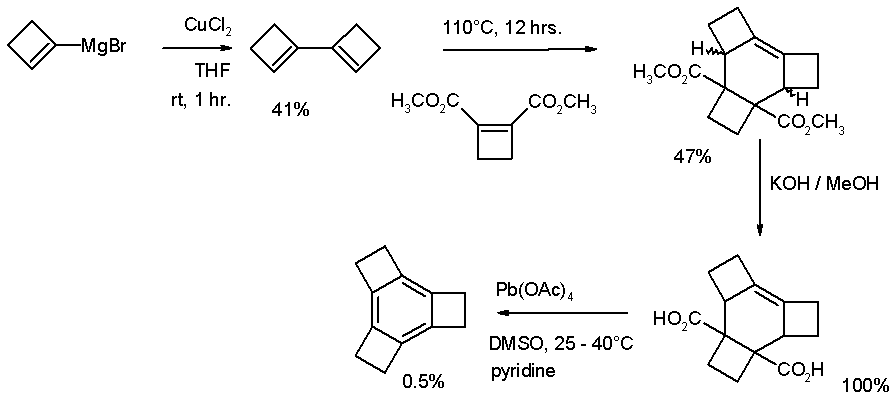Tricyclobutabenzene on:
[Wikipedia]
[Google]
[Amazon]
Tricyclobutabenzene is an  A polyoxygenated tricyclobutabenzene with an extraordinary
A polyoxygenated tricyclobutabenzene with an extraordinary  An ordinary bond of this type is only 148 pm and for comparison the C-C bond in
An ordinary bond of this type is only 148 pm and for comparison the C-C bond in 
aromatic hydrocarbon
Aromatic compounds, also known as "mono- and polycyclic aromatic hydrocarbons", are organic compounds containing one or more aromatic rings. The parent member of aromatic compounds is benzene. The word "aromatic" originates from the past grouping ...
consisting of a benzene
Benzene is an organic chemical compound with the molecular formula C6H6. The benzene molecule is composed of six carbon atoms joined in a planar ring with one hydrogen atom attached to each. Because it contains only carbon and hydrogen atoms, ...
core with three cyclobutane
Cyclobutane is a cycloalkane and organic compound with the formula (CH2)4. Cyclobutane is a colourless gas and commercially available as a liquefied gas. Derivatives of cyclobutane are called cyclobutanes. Cyclobutane itself is of no commercial ...
rings fused onto it. This compound and related compounds are studied in the laboratory because they are often displaying unusual conformations and because of their unusual reactivity. Tricyclobutabenzenes are isomer
In chemistry, isomers are molecules or polyatomic ions with identical molecular formulae – that is, same number of atoms of each element – but distinct arrangements of atoms in space. Isomerism is existence or possibility of isomers.
Iso ...
s of radialene are alicyclic organic compounds containing n cross-conjugated exocyclic double bonds. The double bonds are commonly alkene groups but those with a carbonyl (C=O) group are also called radialenes. For some members the unsubstituted parent radialen ...
s and form an equilibrium with them.
The parent tricyclobutabenzene (C12H12) was first synthesised in 1979 by the following sequence: This compound is stable up to .
: A polyoxygenated tricyclobutabenzene with an extraordinary
A polyoxygenated tricyclobutabenzene with an extraordinary bond length
In molecular geometry, bond length or bond distance is defined as the average distance between nuclei of two bonded atoms in a molecule. It is a transferable property of a bond between atoms of fixed types, relatively independent of the rest of ...
of 160 pm for the bond connecting two carbonyl groups by the following sequence:
: An ordinary bond of this type is only 148 pm and for comparison the C-C bond in
An ordinary bond of this type is only 148 pm and for comparison the C-C bond in isatin
Isatin, also known as tribulin, is an organic compound derived from indole with formula C8H5NO2. The compound was first obtained by Otto Linné Erdman and Auguste Laurent in 1840 as a product from the oxidation of indigo dye by nitric acid and ...
is 154 pm long. On the other hand, no change is recorded in the aromatic bond length alternation.
Similar chemistry yielded the six-fold ketone hexaoxotricyclobutabenzene
Hexaoxotricyclobutabenzene is an organic compound with formula C12O6. It can be viewed as the sixfold ketone of tricyclobutabenzene.
It is an oxide of carbon, detected by 13C NMR in 2006.
References
Oxocarbons
Cyclobutenes
Enones
...
C12O6, which happens to be a novel oxide of carbon.''Dodecamethoxy- and Hexaoxotricyclobutabenzene: Synthesis and Characterization'' Toshiyuki Hamura, Yousuke Ibusuki, Hidehiro Uekusa, Takashi Matsumoto, Jay S. Siegel, Kim K. Baldridge, and Keisuke Suzuki J. Am. Chem. Soc.
The ''Journal of the American Chemical Society'' is a weekly peer-reviewed scientific journal that was established in 1879 by the American Chemical Society. The journal has absorbed two other publications in its history, the ''Journal of Analytic ...
; 2006; 128(31) pp 10032 - 10033; A key starting material is the iodo triflate depicted below which is a benzotriyne
Benzotriyne or cyclo arbon is a hypothetical compound, an allotrope of carbon with molecular formula . The molecule is a ring of six carbon atoms, connected by alternating triple and single bonds. It is, therefore, a potential member of the ...
synthon
In retrosynthetic analysis, a synthon is a hypothetical unit within a target molecule that represents a potential starting reagent in the retroactive synthesis of that target molecule. The term was coined in 1967 by E. J. Corey. He noted in 19 ...
.
:
See also
*Biphenyl
Biphenyl (also known as diphenyl, phenylbenzene, 1,1′-biphenyl, lemonene or BP) is an organic compound that forms colorless crystals. Particularly in older literature, compounds containing the functional group consisting of biphenyl less one ...
* Triphenyl
* Terpyridine
Terpyridine (2,2';6',2"-terpyridine, often abbreviated to Terpy or Tpy) is a heterocyclic compound derived from pyridine. It is a white solid that is soluble in most organic solvents. The compound is mainly used as a ligand in coordination chemist ...
* Terthiophene
Terthiophene is the organic compound with the formula 4H3Ssub>2C4H2S. It is an oligomer of the heterocycle thiophene, a shorter oligomer is dithienyl, and the parent polymer is polythiophene. In the most common isomer of terthiophene, two thien ...
* Naphthalene
Naphthalene is an organic compound with formula . It is the simplest polycyclic aromatic hydrocarbon, and is a white crystalline solid with a characteristic odor that is detectable at concentrations as low as 0.08 ppm by mass. As an aromati ...
where the rings are fused
References
{{PAHs Polycyclic aromatic hydrocarbons Tetracyclic compounds Cyclobutanes Cyclobutenes